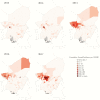Spatiotemporal Analysis of Serogroup C Meningococcal Meningitis Spread in Niger and Nigeria and Implications for Epidemic Response
- PMID: 31671446
- PMCID: PMC6822969
- DOI: 10.1093/infdis/jiz343
Spatiotemporal Analysis of Serogroup C Meningococcal Meningitis Spread in Niger and Nigeria and Implications for Epidemic Response
Abstract
Background: After the re-emergence of serogroup C meningococcal meningitis (MM) in Nigeria and Niger, we aimed to re-evaluate the vaccination policy used to respond to outbreaks of MM in the African meningitis belt by investigating alternative strategies using a lower incidence threshold and information about neighboring districts.
Methods: We used data on suspected and laboratory-confirmed cases in Niger and Nigeria from 2013 to 2017. We calculated global and local Moran's I-statistics to identify spatial clustering of districts with high MM incidence. We used a Pinner model to estimate the impact of vaccination campaigns occurring between 2015 and 2017 and to evaluate the impact of 3 alternative district-level vaccination strategies, compared with that currently used.
Results: We found significant clustering of high incidence districts in every year, with local clusters around Tambuwal, Nigeria in 2013 and 2014, Niamey, Niger in 2016, and in Sokoto and Zamfara States in Nigeria in 2017.We estimate that the vaccination campaigns implemented in 2015, 2016, and 2017 prevented 6% of MM cases. Using the current strategy but with high coverage (85%) and timely distribution (4 weeks), these campaigns could have prevented 10% of cases. This strategy required the fewest doses of vaccine to prevent a case. None of the alternative strategies we evaluated were more efficient, but they would have prevented the occurrence of more cases overall.
Conclusions: Although we observed significant spatial clustering in MM in Nigeria and Niger between 2013 and 2017, there is no strong evidence to support a change in methods for epidemic response in terms of lowering the intervention threshold or targeting neighboring districts for reactive vaccination.
Keywords: Niger; Nigeria; epidemic response; meningitis; vaccine.
© The Author(s) 2019. Published by Oxford University Press for the Infectious Diseases Society of America.
Figures




References
-
- World Health Organization. Control of epidemic meningococcal diseases: WHO practical guidelines. Geneva, Switzerland: WHO/Ed Found Marcel Merieux, 1995.
-
- World Health Organization. Detecting meningococcal meningitis epidemics in highly endemic African countries. Wkly Epidemiol Rec 2000. [cited 2016 Jan 23]; 75:305 Available from: http://tf5lu9ym5n.scholar.serialssolutions.com/?sid=google&aulast=World+.... - PubMed
-
- Trotter CL, Cibrelus L, Fernandez K, Lingani C, Ronveaux O, Stuart JM. Response thresholds for epidemic meningitis in sub-Saharan Africa following the introduction of MenAfriVac®. Vaccine 2015; 33:6212–7. - PubMed
-
- World Health Organization. WHO Guideline on meningitis outbreak response. 2014. Available from: https://www.who.int/csr/resources/publications/meningitis/guidelines2014.... Accessed 26 July 2019.

